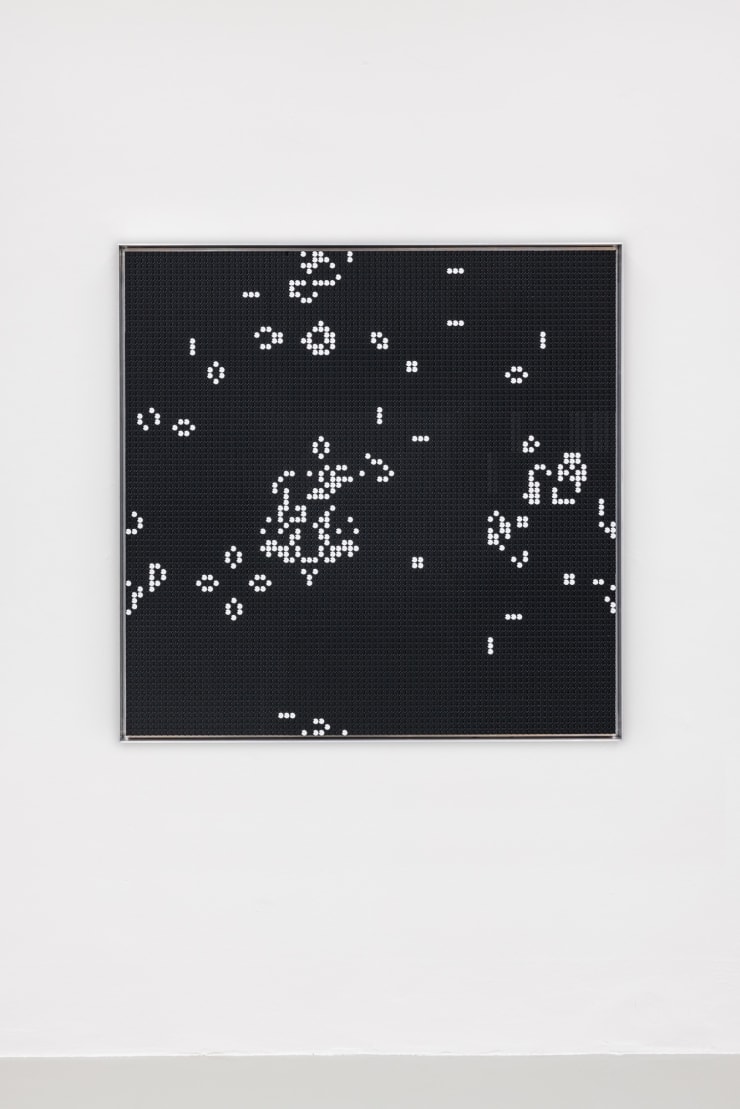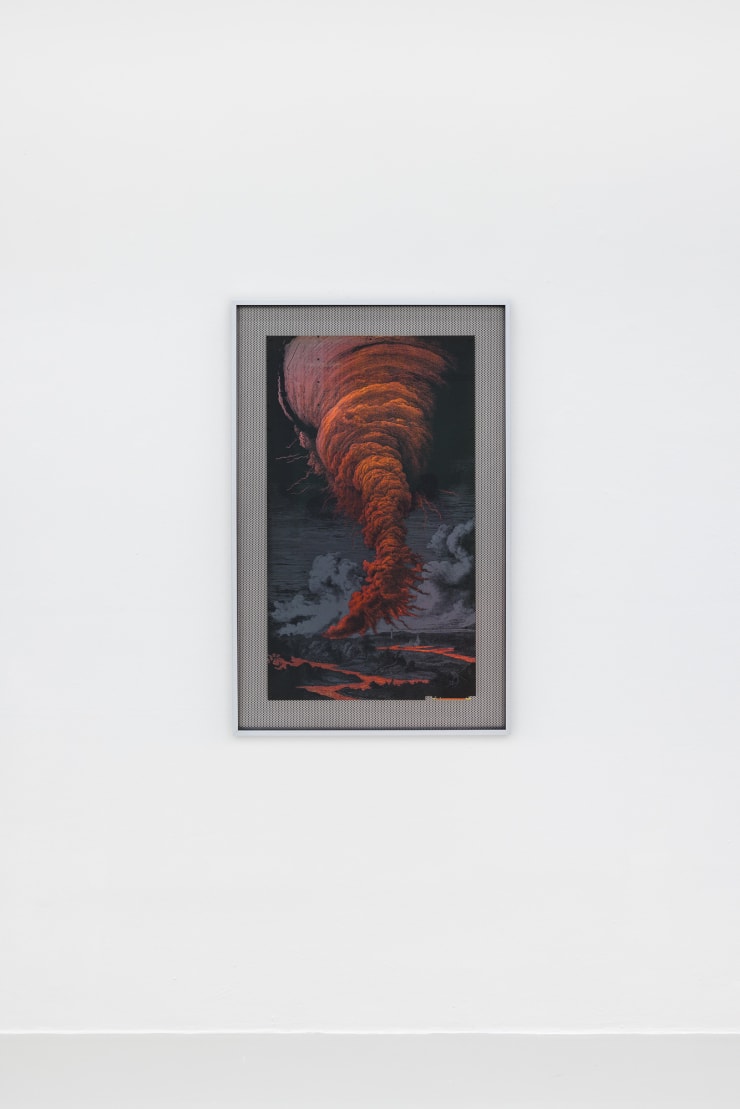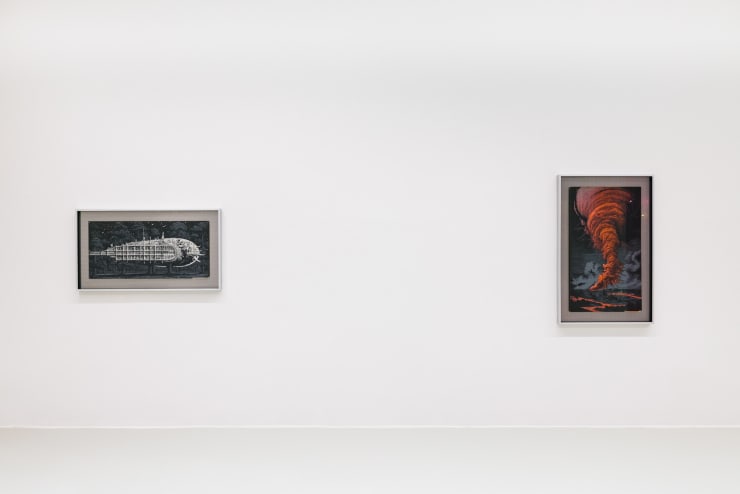Andreas Greiner | Game of Life
*With the kind support of ElevenLabs, New York, USA
-
 Andreas GreinerExodus, 2023printed circuit board (PCB) with conducting paths and soldered microchip, framed in aluminium80 x 125 x 5 cm; 31 1/2 x 49 1/4 x 2 in; Edition of 4 + 3 AP (Photo by Jens Ziehe, Image Courtesy Dittrich & Schlechtriem)
Andreas GreinerExodus, 2023printed circuit board (PCB) with conducting paths and soldered microchip, framed in aluminium80 x 125 x 5 cm; 31 1/2 x 49 1/4 x 2 in; Edition of 4 + 3 AP (Photo by Jens Ziehe, Image Courtesy Dittrich & Schlechtriem) -
 Andreas GreinerConspiracy Theory, 2023AI computer, cofee maker, chandelier with three speakers and three seedlings communicating by AI, table, chairs; dimensions variable Site-specifc unique piece
Andreas GreinerConspiracy Theory, 2023AI computer, cofee maker, chandelier with three speakers and three seedlings communicating by AI, table, chairs; dimensions variable Site-specifc unique piece -
 Andreas GreinerHybrid Estate, 2023Autonom driving bonsai-tree, tent with solarpanel, grow light, NFJT framed in aluminiumdimensions variable Site-specifc unique piece
Andreas GreinerHybrid Estate, 2023Autonom driving bonsai-tree, tent with solarpanel, grow light, NFJT framed in aluminiumdimensions variable Site-specifc unique piece -
 Andreas GreinerFive Feet High and Rising, 2023printed circuit board (PCB) with conducting paths and soldered microchip, framed in aluminium80 x 125 x 5 cm; 31 1/2 x 49 1/4 x 2 in; Edition of 4 + 3 AP (Photo by Jens Ziehe, Image Courtesy Dittrich & Schlechtriem)
Andreas GreinerFive Feet High and Rising, 2023printed circuit board (PCB) with conducting paths and soldered microchip, framed in aluminium80 x 125 x 5 cm; 31 1/2 x 49 1/4 x 2 in; Edition of 4 + 3 AP (Photo by Jens Ziehe, Image Courtesy Dittrich & Schlechtriem) -
 Andreas GreinerThe Game, 2023Flip dot modules, driver, coding, framed in aluminium125 x 125 x 8 cm; 49 1/4 x 49 1/4 x 3 1/8 in; Edition of 4 + 2 AP (Photo by Jens Ziehe, Image Courtesy Dittrich & Schlechtriem)
Andreas GreinerThe Game, 2023Flip dot modules, driver, coding, framed in aluminium125 x 125 x 8 cm; 49 1/4 x 49 1/4 x 3 1/8 in; Edition of 4 + 2 AP (Photo by Jens Ziehe, Image Courtesy Dittrich & Schlechtriem) -
 Andreas GreinerBlowin’ In The Wind, 2023printed circuit board (PCB) with conducting paths and soldered microchip, framed in aluminium125 x 80 x 5 cm; 49 1/4 x 31 1/2 x 2 in; Edition of 4 + 3 AP (Photo by Jens Ziehe, Image Courtesy Dittrich & Schlechtriem)
Andreas GreinerBlowin’ In The Wind, 2023printed circuit board (PCB) with conducting paths and soldered microchip, framed in aluminium125 x 80 x 5 cm; 49 1/4 x 31 1/2 x 2 in; Edition of 4 + 3 AP (Photo by Jens Ziehe, Image Courtesy Dittrich & Schlechtriem) -
 Andreas GreinerJoint Venture, 2023vegetated graphics processing unit (GPU), framed in aluminium30 x 20 cm
Andreas GreinerJoint Venture, 2023vegetated graphics processing unit (GPU), framed in aluminium30 x 20 cm
11 3/4 x 7 7/8 inUnique in series of 4(Edition record) -
 Bernard Viennat & Andreas GreinerNFJT (part of the work Hybrid Estate), 2023Engraved coin, framed in aluminium7.5 x 7.5 x 2 cm; 3 x 3 x 3/4 in
Bernard Viennat & Andreas GreinerNFJT (part of the work Hybrid Estate), 2023Engraved coin, framed in aluminium7.5 x 7.5 x 2 cm; 3 x 3 x 3/4 in -
 Andreas GreinerMovement to Venus, 2023printed circuit board (PCB) with conducting paths and soldered microchip, framed in aluminium68 x 125 x 5 cm; 26 3/4 x 49 1/4 x 2 in; Edition of 4 + 3 AP (Photo by Jens Ziehe, Image Courtesy Dittrich & Schlechtriem)
Andreas GreinerMovement to Venus, 2023printed circuit board (PCB) with conducting paths and soldered microchip, framed in aluminium68 x 125 x 5 cm; 26 3/4 x 49 1/4 x 2 in; Edition of 4 + 3 AP (Photo by Jens Ziehe, Image Courtesy Dittrich & Schlechtriem) -
 Andreas GreinerMolly Aida, 2023printed circuit board (PCB) with conducting paths and soldered microchip, framed in aluminium85 x 57 x 5 cm; 33 1/2 x 22 1/2 x 2 in; Edition 3/4 + 3 AP
Andreas GreinerMolly Aida, 2023printed circuit board (PCB) with conducting paths and soldered microchip, framed in aluminium85 x 57 x 5 cm; 33 1/2 x 22 1/2 x 2 in; Edition 3/4 + 3 AP
The essence of Andreas Greiner's exhibition is encapsulated in the title 'Game of Life,' inspired by mathematician John Horton Conway's real game from the 1970s. In Conway's game, 'living dots' perish with fewer than two or more than three neighbors, while 'dead dots' revive with precisely three neighbors. Their fate hinges on the dynamics of the immediate environment, primarily determined by neighboring dots. Greiner employs the title ‘Game of Life’ metaphorically, envisioning the exhibition space as a socio-technological game field. Within this conceptual arena, humans, hybrid beings, and artificial intelligences assume roles akin to the dots in a larger narrative. Embark upon a whimsical journey filled with auditory and visual marvels, infused with a nostalgic mood, offering a glimpse into Greiner's envisioned future.
Greiner's depiction of an alternate reality unfolds across two distinct rooms, highlighting the evolving nature of the narrative. In the initial room, motifs are intricately etched onto microcircuits designed by Greiner using AI and PCB (printed circuit board) software. Among these, captivating scenes include a seascape with dramatic swells, floating zeppelins, and a surreal tornado — all resembling dreamscapes crafted with meticulous detail. The environment is revealed through the lens of media archaeology, unearthing fragments of the past that resonate as significant notes for the future. The presentation conjures a utopian/dystopian ambiance, portraying familiar objects and scenes without the presence of humans, prompting contemplation on alternate realities.
Amidst the two stages, a hybrid entity emerges—a bonsai robot embodying a delicately stunted olive tree. It traverses the exhibition space, equipped with a luminous camera eye capturing images of visitors. These images are then transmitted to a server and projected on a monitor, accompanied by an AI analysis of the individuals, creating a fascinating synthesis of organic and technological interactions. Prior to entering the second room, a designated home for the bonsai is established, complete with a growth lamp. This setup allows the technical components to absorb energy, ensuring the illumination of the tree.
The second room is inspired by the concept of the Viennese coffee house. Thonet chairs, paired with two bistro tables and a distinctive Sputnik chandelier with a unique touch – adorned with speakers and plants – complement the lights arranged around the core of the lamp, enhancing the ambiance. This inviting setting encourages guests to enjoy a cup of coffee while engaging with the conversations of AI characters. These characters offer a mix of accurate, flawed, charming, and straightforward descriptions of visitors, along with their attempts to discuss socio-political topics. Adding to the experience, the voices of three invisible protagonists—an astronaut, a psychoanalyst, and a theoretical physicist—emerge from the speakers.
These voices, with varying tones, convey a sense of diversity, yet no one is physically present. They belong to chatbots and artificial intelligences created by various large language models (such as LlaMA or Chat GPT) and text-to-speech technologies, including ElevenLabs*. This fusion of traditional atmosphere with modern technological elements creates a captivating and thought-provoking backdrop within the exhibition space. Last but not least, there is an artwork that evokes Conway's Game, which also shares its title with the exhibition. It features patterns that change and move within a specific time frame, creating combinations that resemble neurons, viruses, or bacteria.
The exhibition touches the boundary between the familiar and the uncanny. Greiner initiates the exploration with elements from the early nineteenth century, gradually navigating through the decades, culminating in an exploration of artificial intelligence. Mirroring the journey of the traveling bonsai, visitors and spectators traverse different periods and spaces, encountering a multitude of paradoxes throughout the exhibition.
Do we yield to AI under the assumption of its superior intelligence, or is the true intelligence within us, as beings capable of utilizing AI for our own objectives? Can we anticipate and adapt to a potential future epoch or phase succeeding the Anthropocene, given its intricate connections with the environment? The objective here is to portray a future wherein our influence on the planet is not only balanced but also characterized by regeneration and resilience.
Text by Olympia Tzortzi
*With the kind support of ElevenLabs, New York, USA















